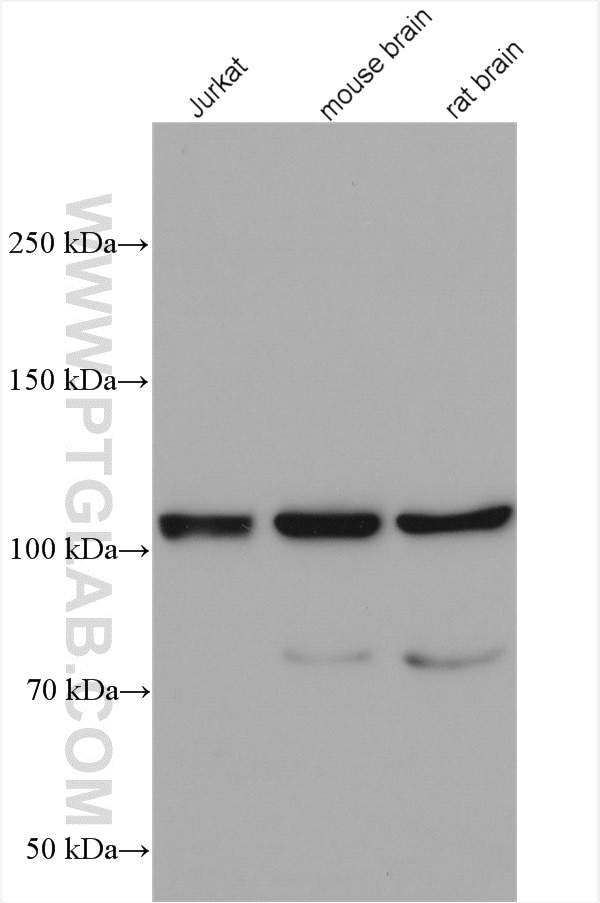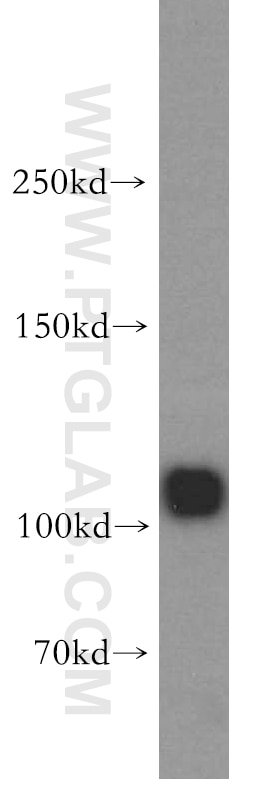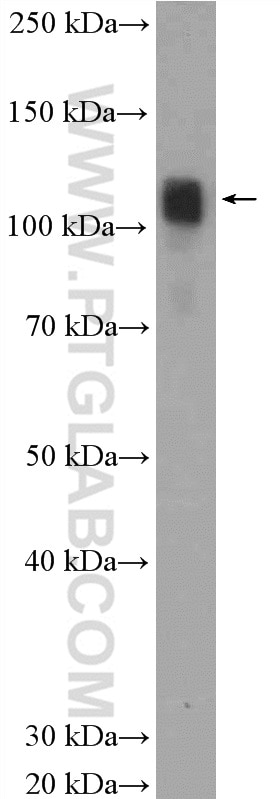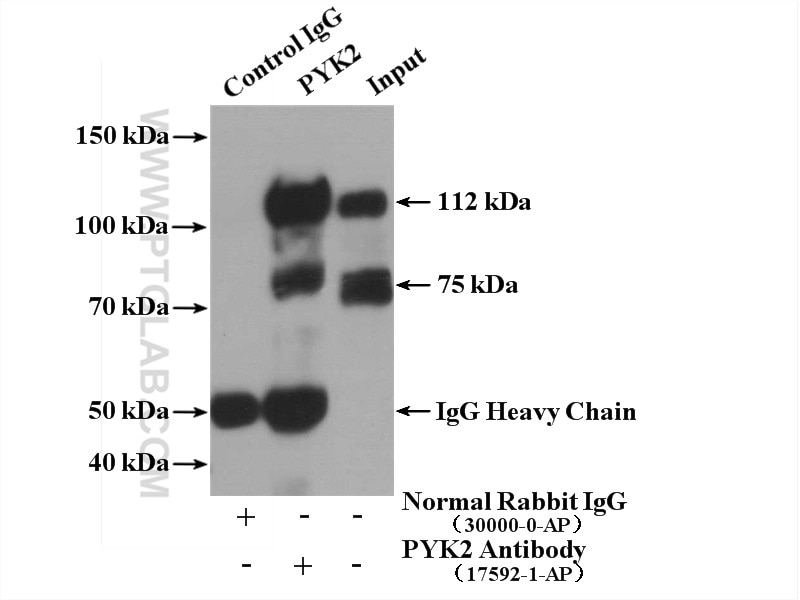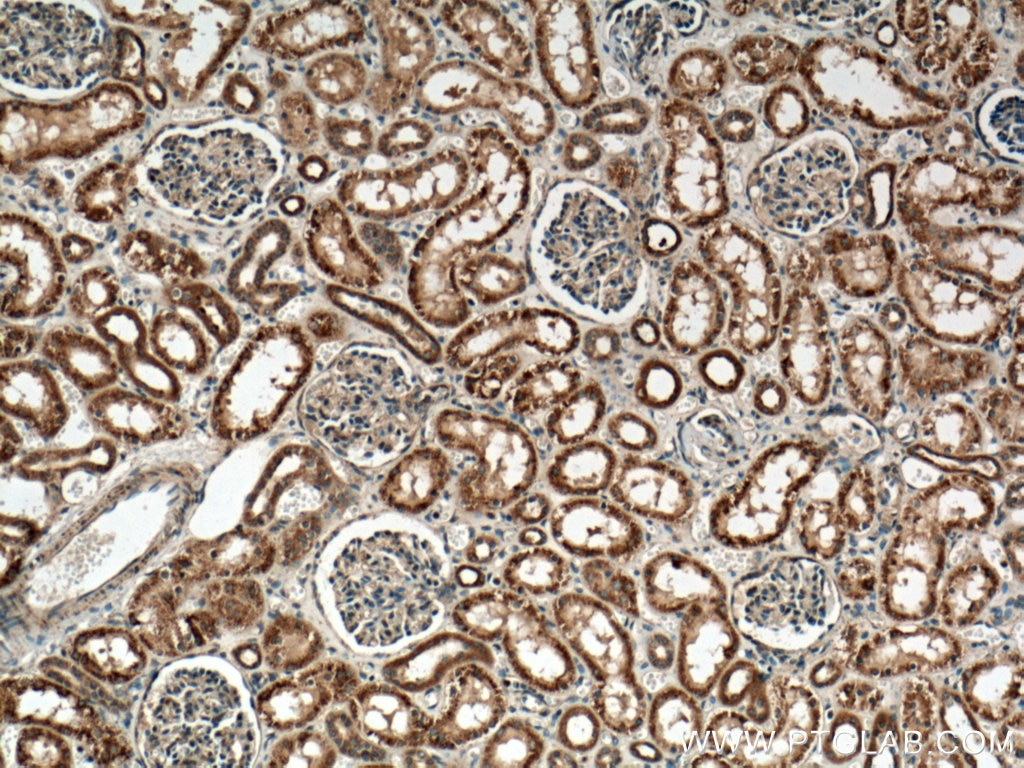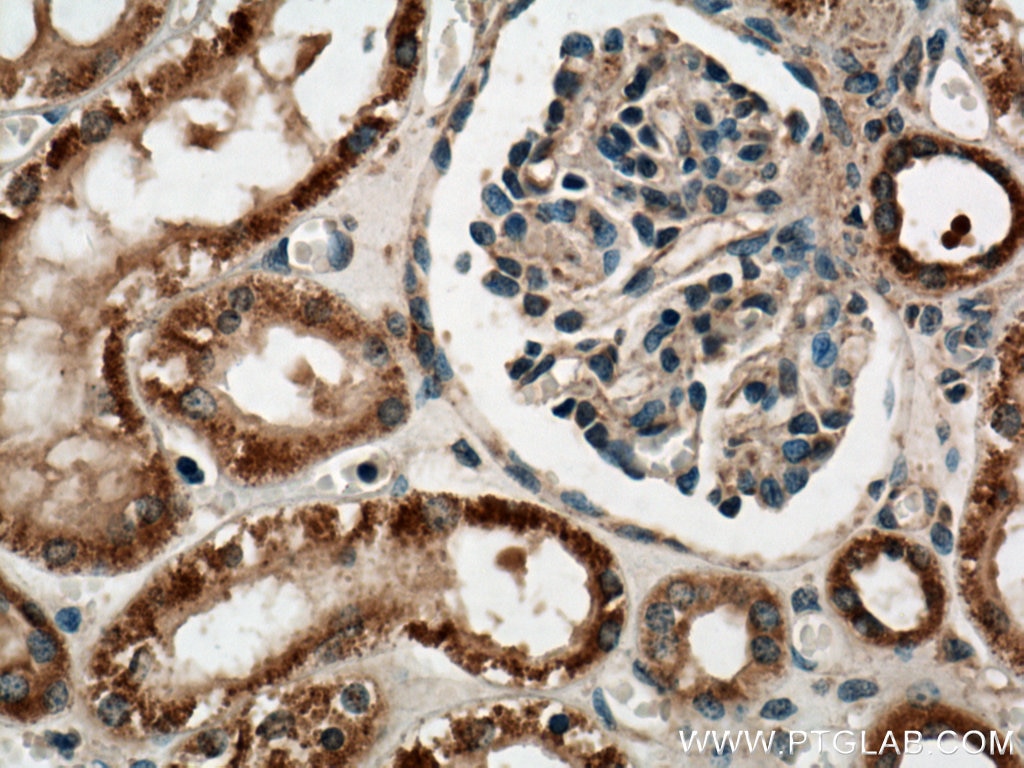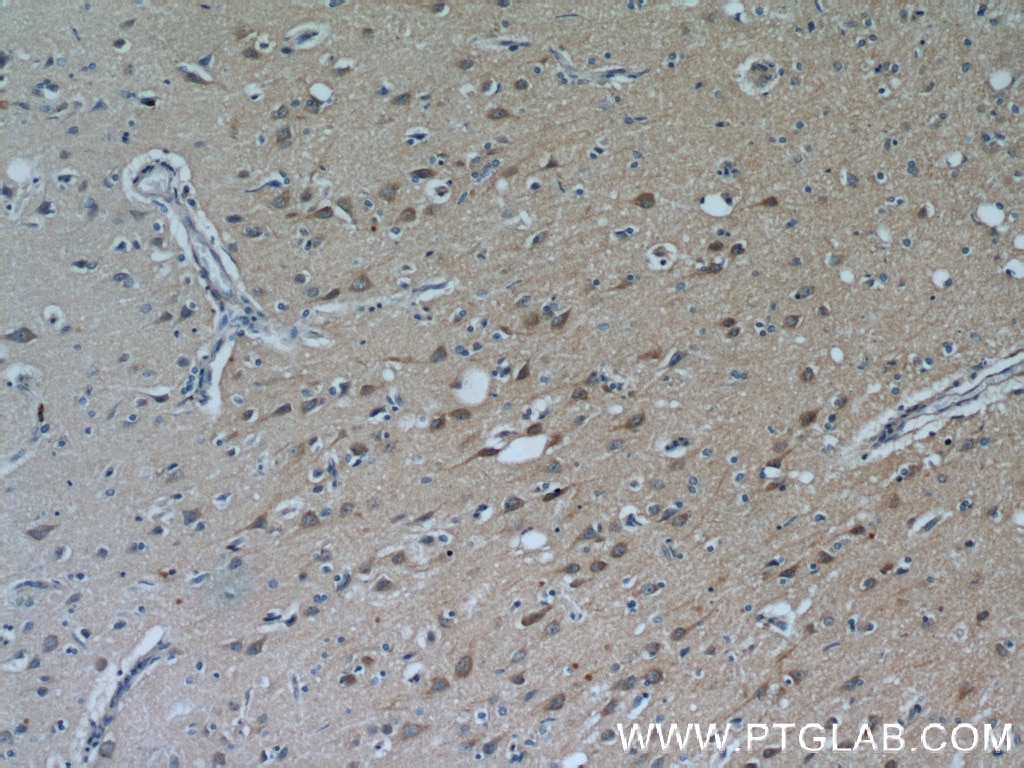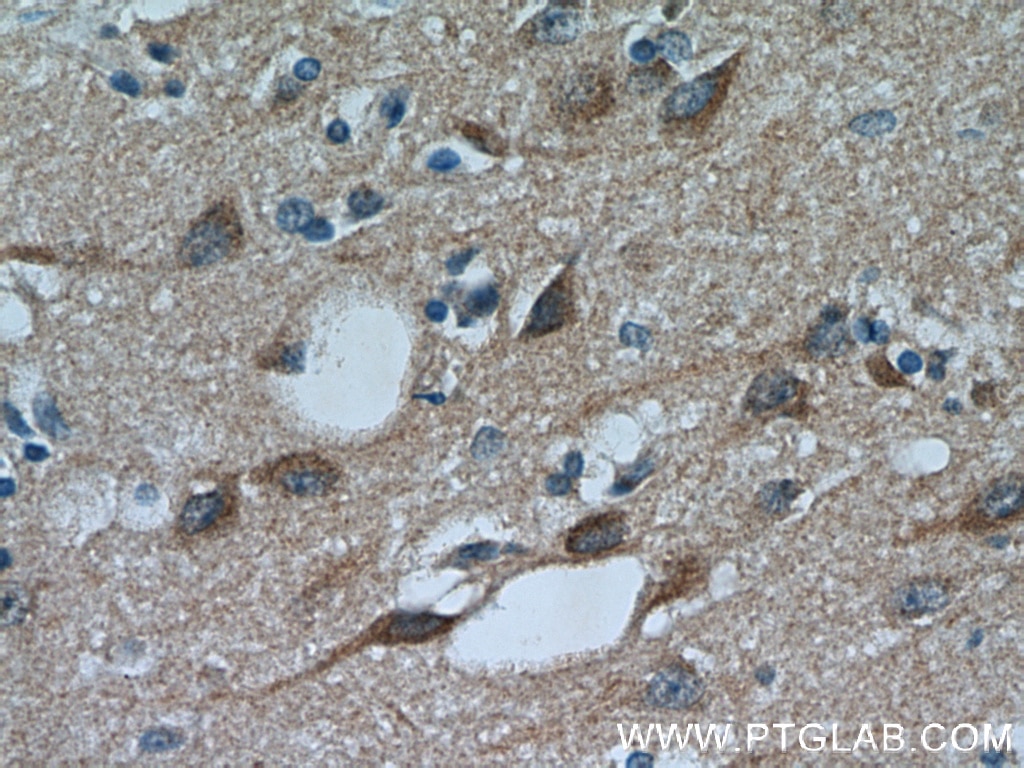Tested Applications
| Positive WB detected in | Jurkat cells, rat brain tissue, mouse brain tissue |
| Positive IP detected in | mouse brain tissue |
| Positive IHC detected in | human kidney tissue, human brain tissue Note: suggested antigen retrieval with TE buffer pH 9.0; (*) Alternatively, antigen retrieval may be performed with citrate buffer pH 6.0 |
Recommended dilution
| Application | Dilution |
|---|---|
| Western Blot (WB) | WB : 1:3000-1:10000 |
| Immunoprecipitation (IP) | IP : 0.5-4.0 ug for 1.0-3.0 mg of total protein lysate |
| Immunohistochemistry (IHC) | IHC : 1:50-1:500 |
| It is recommended that this reagent should be titrated in each testing system to obtain optimal results. | |
| Sample-dependent, Check data in validation data gallery. | |
Published Applications
| WB | See 9 publications below |
| IHC | See 3 publications below |
| IF | See 1 publications below |
| IP | See 3 publications below |
Product Information
17592-1-AP targets PYK2 in WB, IHC, IF, IP, ELISA applications and shows reactivity with human, mouse, rat samples.
| Tested Reactivity | human, mouse, rat |
| Cited Reactivity | human, mouse |
| Host / Isotype | Rabbit / IgG |
| Class | Polyclonal |
| Type | Antibody |
| Immunogen |
CatNo: Ag11487 Product name: Recombinant human PTK2B protein Source: e coli.-derived, PET28a Tag: 6*His Domain: 646-1009 aa of BC042599 Sequence: KPDLCPPVLYTLMTRCWDYDPSDRPRFTELVCSLSDVYQMEKDIAMEQERNARYRTPKILEPTAFQEPPPKPSRPKYRPPPQTNLLAPKLQFQVPEGLCASSPTLTSPMEYPSPVNSLHTPPLHRHNVFKRHSMREEDFIQPSSREEAQQLWEAEKVKMRQILDKQQKQMVEDYQWLRQEEKSLDPMVYMNDKSPLTPEKEVGYLEFTGPPQKPPRLGAQSIQPTANLDRTDDLVYLNVMELVRAVLELKNELCQLPPEGYVVVVKNVGLTLRKLIGSVDDLLPSLPSSSRTEIEGTQKLLNKDLAELINKMRLAQQNAVTSLSEECKRQMLTASHTLAVDAKNLLDAVDQAKVLANLAHPPAE Predict reactive species |
| Full Name | PTK2B protein tyrosine kinase 2 beta |
| Calculated Molecular Weight | 1009 aa, 116 kDa |
| Observed Molecular Weight | 112-115 kDa |
| GenBank Accession Number | BC042599 |
| Gene Symbol | PTK2B |
| Gene ID (NCBI) | 2185 |
| RRID | AB_10644483 |
| Conjugate | Unconjugated |
| Form | Liquid |
| Purification Method | Antigen affinity purification |
| UNIPROT ID | Q14289 |
| Storage Buffer | PBS with 0.02% sodium azide and 50% glycerol, pH 7.3. |
| Storage Conditions | Store at -20°C. Stable for one year after shipment. Aliquoting is unnecessary for -20oC storage. 20ul sizes contain 0.1% BSA. |
Background Information
Proline-rich tyrosine kinase 2 (Pyk2; also known as CAK, RAFTK and CADTK) is a cytoplasmic tyrosine kinase implicated to play a role in several intracellular signaling pathways. It is expressed in many cells and tissues and migrated as a 130 kDa band in Western Blotting analysis. The size of PYK2 is 115 kDa, and it expressed in many cells and tissues and migrated as a 130 kDa band, but several lower molecular weight bands (75 kDa, 80 kDa, and 97 kDa) were seen in Western Blotting analysis, possibly due to proteolytic degradation.
Protocols
| Product Specific Protocols | |
|---|---|
| IP protocol for PYK2 antibody 17592-1-AP | Download protocol |
| WB protocol for PYK2 antibody 17592-1-AP | Download protocol |
| IHC protocol for PYK2 antibody 17592-1-AP | Download protocol |
| Standard Protocols | |
|---|---|
| Click here to view our Standard Protocols |
Publications
| Species | Application | Title |
|---|---|---|
Int J Cancer Plant galactolipid dLGG suppresses lung metastasis of melanoma through deregulating TNF-α-mediated pulmonary vascular permeability and circulating oxylipin dynamics in mice. | ||
Mucosal Immunol ADP/P2Y1 aggravates inflammatory bowel disease through ERK5-mediated NLRP3 inflammasome activation. | ||
Cancer Cell Int Inhibiting Pyk2/Src expression by miR-23b-3p suppressed liver cancer stem cell function and hepatic carcinoma progression | ||
EBioMedicine Biallelic mutations in LAMA5 disrupts a skeletal noncanonical focal adhesion pathway and produces a distinct bent bone dysplasia. | ||
Cell Signal Identification of NCK1 as a novel downstream effector of STAT3 in colorectal cancer metastasis and angiogenesis. | ||
Stem Cell Rev Rep A Novel Splicing Mutation c.335-1 G > A in the Cardiac Transcription Factor NKX2-5 Leads to Familial Atrial Septal Defect Through miR-19 and PYK2. |

